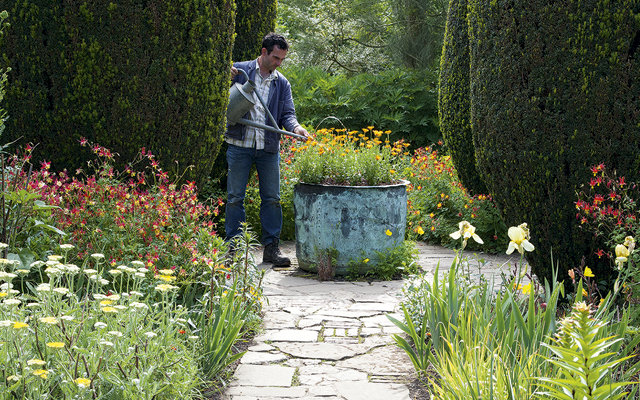The secrets of the cottage garden
Troy Scott Smith's secrets of the cottage garden.


The Cottage Garden at Sissinghurst was a favourite with both Vita and Harold the innermost of what Harold called a ‘succession of privacies’. It is an intimate, enclosed space and, although visually connected to the rest of Sissinghurst, with views of the Elizabethan tower and the Tudor front range, it feels secluded. Vita and Harold both had bedrooms in the cottage that sits sentinel overlooking the garden; Harold had an office in it, too.
The name Cottage Garden is misleading, however, for its range of plants extends well beyond the traditional hardy species found in gardens up and down the country. It includes tender exotics such as hedychiums, salvias and cannas. Vita restricted the colour range to variations on sunset hues of orange, red and yellow.
In spring, the plants are low, but they generously fill the beds so that, everywhere, fat cushions of flower and foliage sprawl and spill over paths, lending a generous and romantic luxuriance. Drifts of yellow helianthemum, scarlet geum and bright orange trollius are punctuated with swathes of dusky tulips and just enough foliage from columbines, irises and daylilies to knit the whole thing together.
In summer, you can feel your pulse racing as the garden throbs in a tidal wave of colour, none more spectacular than the amazing vermilion-coloured flowers of Crocosmia Lucifer in tandem with the indispensable Dahlia Bishop of Llandaff.
Dahlias in a range of shades have always been a conspicuous element within the Cottage Garden and were a favourite of Harold’s; they include Yellow Hammer, bright orange East Court, gentle orange Autumn Lustre, vermilion Dahlia coccinea and lemon-yellow Glorie van Heemstede.
Tender shrubby salvias, such as S. fulgens, are also an important element, together with clusters of flat heads of Achillea and the red-hot pokers—which Vita liked and Harold hated.
Keeping any garden but particularly a south-facing, ‘hot’ garden going through the summer months is about timely watering as much as anything else.
Sign up for the Country Life Newsletter
Exquisite houses, the beauty of Nature, and how to get the most from your life, straight to your inbox.
Although our clay soil in the Sissinghurst Cottage Garden generally supports established plants quite happily, there comes a moment, usually in August, when one must intervene and irrigate.
However, water is the most valuable of natural resources and potentially an expensive commodity, to be used sparingly, so it is important to understand the needs of plants and take steps to reduce water loss, both from them and from the soil.
The plants that grow in arid regions of the world have developed distinctive ways to minimise water loss or store water in periods of drought and a number of them are in the Cottage Garden. Hairy leaves, for example, help reduce the drying effect of the wind and also reflect the sun’s rays.
Leathery or waxy leaves help prevent water loss and evaporation by the wind. Grasses and conifers are good examples of plants with thin, needle-like leaves. The small surface area loses very little water and some plants will roll their leaves inwards, reducing their surface even more.
On heavy clay soils, plants with extensive, fine root systems will seek out the smallest amount of water caught between the soil particles. To give plants the best chance of seeking out this moisture, incorporate grit to open the soil and organic matter to enrich it.
The hardest thing is to apply the right amount of water: too much is wasteful and too little will cause the roots to come to the surface. Established plants need about an inch of water every 10 days in dry spells. It’s not worthwhile just making the soil damp; it has to be thoroughly wetted for the water to travel down to the roots.
Clay soil has many small particles, so although it might hold rain, some water is held so tightly that plants can’t access it. It’s always better to give plants a good soaking than to water little and often and to do it in the evening or early morning to reduce evaporation.
Country Life is unlike any other magazine: the only glossy weekly on the newsstand and the only magazine that has been guest-edited by HRH The King not once, but twice. It is a celebration of modern rural life and all its diverse joys and pleasures — that was first published in Queen Victoria's Diamond Jubilee year. Our eclectic mixture of witty and informative content — from the most up-to-date property news and commentary and a coveted glimpse inside some of the UK's best houses and gardens, to gardening, the arts and interior design, written by experts in their field — still cannot be found in print or online, anywhere else.
-
 ‘David Hockney 25’ at the Fondation Louis Vuitton: Britain’s most influential contemporary artist pops up in Paris to remind us all of the joys of spring
‘David Hockney 25’ at the Fondation Louis Vuitton: Britain’s most influential contemporary artist pops up in Paris to remind us all of the joys of springThe biggest-ever David Hockney show has opened inside the Fondation Louis Vuitton in Paris — in time for the season that the artist has become synonymous with.
By Amy Serafin Published
-
 High Wardington House: A warm, characterful home that shows just what can be achieved with thought, invention and humour
High Wardington House: A warm, characterful home that shows just what can be achieved with thought, invention and humourAt High Wardington House in Oxfordshire — the home of Mr and Mrs Norman Hudson — a pre-eminent country house adviser has created a home from a 300-year-old farmhouse and farmyard. Jeremy Musson explains; photography by Will Pryce for Country Life.
By Jeremy Musson Published